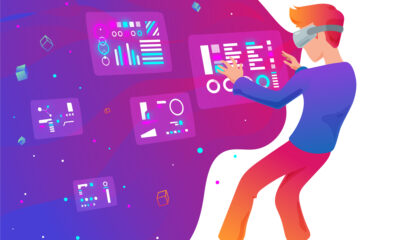Tech
Develop an Interactive Decentralized Platform with Web3

Introduction
The world of technology is constantly evolving, and one of the latest trends that has captured the attention of developers and enthusiasts alike is the concept of Web3 development. With the rise of blockchain technology and cryptocurrencies, there is a growing need for interactive decentralized platforms that can harness the power of this innovative technology.
In this article, we will explore the concept of developing an interactive decentralized platform with Web3 development services. We will delve into the key aspects, benefits, and challenges associated with this process. So, let’s dive in and discover the exciting world of Web3 development!
What is Web3 Development?
Before we delve into the intricacies of developing an interactive decentralized platform, let’s first understand what Web3 development is all about. Web3 refers to the next generation of the internet, where decentralized applications (dApps) and smart contracts built on blockchain technology take center stage. Unlike traditional Web2 applications that rely on centralized servers and intermediaries, Web3 applications leverage the power of blockchain to create a trustless and transparent environment.
Developers working on Web3 development are tasked with creating applications that enable peer-to-peer interactions, facilitate secure transactions, and provide users with complete control over their data. By utilizing blockchain protocols like Ethereum, developers can build decentralized platforms that promote transparency, immutability, and autonomy. This paradigm shift opens up a whole new realm of possibilities, revolutionizing industries such as finance, supply chain, healthcare, and more.
The Need for Interactive Decentralized Platforms
As the world becomes increasingly digitized, the need for interactive decentralized platforms becomes more evident. Traditional centralized platforms often suffer from various limitations, including single points of failure, data breaches, and lack of transparency. On the other hand, interactive decentralized platforms provide a robust and secure framework that addresses these shortcomings.
Interactive decentralized platforms enable direct peer-to-peer interactions without relying on intermediaries. This eliminates the need for trust in a centralized authority, as the blockchain technology ensures data integrity and security. Furthermore, these platforms empower users by giving them control over their own data and removing the risks associated with centralized storage. This enhanced user experience and autonomy have made interactive decentralized platforms highly sought after in a wide range of industries.
Develop an Interactive Decentralized Platform with Web3 Development Services
Choosing the Right Blockchain Platform
When embarking on the journey to develop an interactive decentralized platform, choosing the right blockchain platform is crucial. There are several blockchain platforms available, each with its own unique features and characteristics. Ethereum, for instance, is one of the most popular choices due to its robustness, flexibility, and large developer community. Other platforms like Polkadot and Solana also offer their own advantages and should be evaluated based on specific project requirements.
It’s important to consider factors such as scalability, security, consensus mechanism, and community support when selecting a blockchain platform for your interactive decentralized platform. Conduct thorough research and analysis to make an informed decision that aligns with your project goals and long-term vision.
Designing Smart Contracts for Functionality and Security
Smart contracts are an integral part of any interactive decentralized platform. These self-executing contracts facilitate the exchange of digital assets, enforce business logic, and ensure trust among participants. To develop an effective interactive decentralized platform, it is essential to design smart contracts that are both functional and secure.
When designing smart contracts, consider the specific requirements of your platform and the interactions between various participants. Take into account the data structures, event triggers, and business rules that need to be encoded into the smart contract. Additionally, pay careful attention to security considerations, such as preventing vulnerabilities like reentrancy attacks and ensuring the contract is resistant to malicious actors.
Building User-friendly and Intuitive Interfaces
While the underlying technology of an interactive decentralized platform may be complex, it is crucial to build user-friendly and intuitive interfaces that enable seamless interactions. The success of a decentralized platform relies on attracting and retaining users, and a positive user experience is key to achieving this.
Developers should focus on creating interfaces that are visually appealing, easy to navigate, and provide clear instructions to users. Consider leveraging existing web development frameworks and libraries to accelerate the process and ensure compatibility across different devices and browsers. By prioritizing user experience, you can enhance adoption and drive engagement on your interactive decentralized platform.
Implementing Robust Identity and Access Management
Identity and access management (IAM) plays a vital role in interactive decentralized platforms, where users have complete control over their data. Implementing robust IAM solutions ensures that only authorized users can access specific features and functionalities, while maintaining privacy and security.
Consider utilizing decentralized identity (DID) protocols such as Self-Sovereign Identity (SSI) or integrating with existing IAM frameworks. These protocols provide users with control over their digital identities and allow them to manage access permissions securely. By implementing a strong IAM system, you can enhance the overall security and trustworthiness of your interactive decentralized platform.
Ensuring Scalability and Performance
Scalability and performance are critical aspects of any interactive decentralized platform. As the number of users and transactions grows, the platform should be able to handle the increased load without compromising speed or efficiency. Failure to address scalability concerns can result in a poor user experience and hinder the growth of your platform.
Consider utilizing layer 2 scaling solutions, such as state channels or sidechains, to alleviate the burden on the main blockchain. These solutions enable off-chain transactions while maintaining the security and integrity of the underlying blockchain. Additionally, optimizing smart contract code and leveraging caching mechanisms can significantly improve the performance of your interactive decentralized platform.
Ensuring Regulatory Compliance
While decentralized platforms offer numerous advantages, they also pose unique challenges when it comes to regulatory compliance. Depending on the nature of your platform and the jurisdictions it operates in, you may need to ensure compliance with relevant laws and regulations, such as anti-money laundering (AML) and know your customer (KYC) requirements.
To navigate the regulatory landscape, consider working with legal experts who specialize in blockchain and cryptocurrency regulations. They can provide guidance on compliance frameworks and help you design your interactive decentralized platform in a way that aligns with regulatory requirements.
Frequently Asked Questions (FAQs)
Q: What is the significance of Web3 development in the current technological landscape?
Web3 development is significant as it introduces a paradigm shift towards decentralized applications and blockchain technology. It enables peer-to-peer interactions, enhances user privacy and control, and revolutionizes various industries by eliminating intermediaries and fostering trustless environments.
“Web3 development brings forth a new era of decentralized applications, empowering users and transforming industries through blockchain technology.”
Q: How can interactive decentralized platforms benefit businesses and users?
Interactive decentralized platforms benefit businesses and users by providing enhanced security, transparency, and autonomy. Businesses can streamline operations, reduce costs, and build trust with their customers. Users, on the other hand, gain control over their data, enjoy improved privacy, and engage in peer-to-peer interactions without relying on centralized intermediaries.
“Interactive decentralized platforms offer a win-win situation for businesses and users, fostering trust, security, and empowerment.”
Q: Which industries can benefit from developing interactive decentralized platforms?
Numerous industries can benefit from developing interactive decentralized platforms. Industries such as finance, supply chain, healthcare, gaming, and social media can leverage the advantages of blockchain technology to enhance security, streamline processes, and foster innovation.
“From finance to healthcare, interactive decentralized platforms have the potential to transform various industries and unlock new possibilities.”
Q: What are the challenges associated with developing interactive decentralized platforms?
Developing interactive decentralized platforms comes with its own set of challenges. These challenges include scalability, user adoption, regulatory compliance, smart contract security, and interoperability. Overcoming these challenges requires careful planning, collaboration, and continuous improvement.
“While developing interactive decentralized platforms may pose challenges, overcoming them leads to groundbreaking solutions and a brighter future.”
Q: How can developers ensure the security of interactive decentralized platforms?
Developers can ensure the security of interactive decentralized platforms by following best practices such as conducting thorough smart contract audits, implementing secure coding practices, utilizing decentralized identity protocols, and regularly updating and patching software vulnerabilities. Collaboration with security experts and active community engagement also contribute to a robust security posture.
“Security is paramount in interactive decentralized platforms, and developers must employ industry best practices to safeguard user assets and data.”
Q: What is the future of interactive decentralized platforms and Web3 development?
The future of interactive decentralized platforms and Web3 development is promising. As blockchain technology continues to evolve, we can expect increased adoption, scalability improvements, and integration with emerging technologies like artificial intelligence and the Internet of Things (IoT). The transformative potential of Web3 development is immense and will continue to shape the future of the internet and various industries.
“The future of interactive decentralized platforms is bright, paving the way for a more inclusive, secure, and decentralized internet experience.”
Conclusion
Developing an interactive decentralized platform with Web3 development services opens up a world of possibilities for businesses and users alike. By leveraging blockchain technology, developers can create platforms that are secure, transparent, and empower users to take control of their data and digital interactions. From choosing the right blockchain platform to ensuring scalability, security, and compliance, there are various factors to consider throughout the development process. By addressing these considerations and embracing the potential of Web3 development, we can build a more inclusive, decentralized future.
-
Blog1 year ago
MyCSULB: Login to CSULB Student and Employee Portal – MyCSULB 2023
-
Android App3 years ago
Cqatest App What is It
-
Android1 year ago
What Is content://com.android.browser.home/ All About in 2023? Set Up content com android browser home
-
Software2 years ago
A Guide For Better Cybersecurity & Data Protection For Your Devices
-
Latest News2 years ago
Soap2day Similar Sites And Alternatives To Watch Free Movies
-
Android2 years ago
What is OMACP And How To Remove It? Easy Guide OMACP 2022
-
Android3 years ago
What is org.codeaurora.snapcam?
-
Business2 years ago
Know Your Business (KYB) Process – Critical Component For Partnerships

























